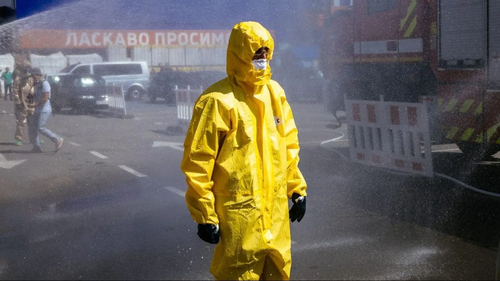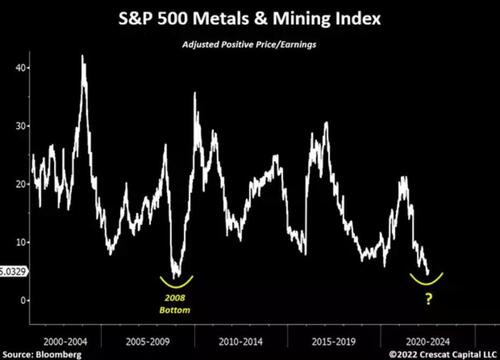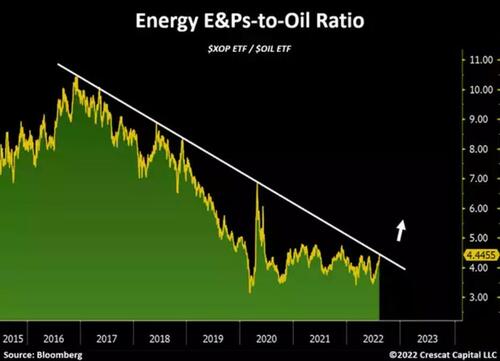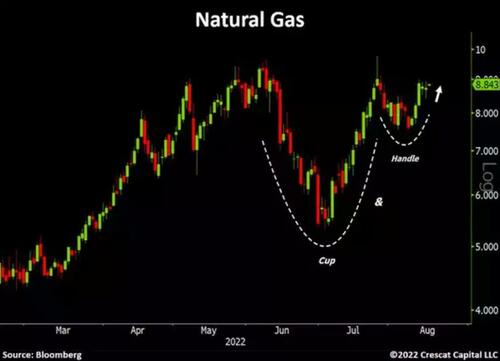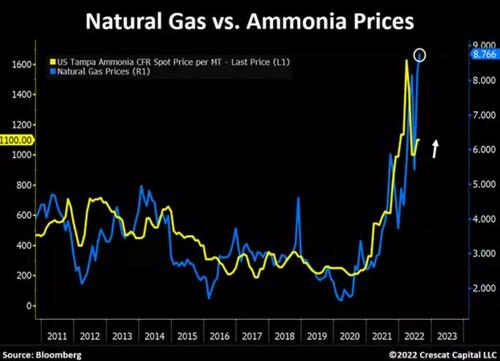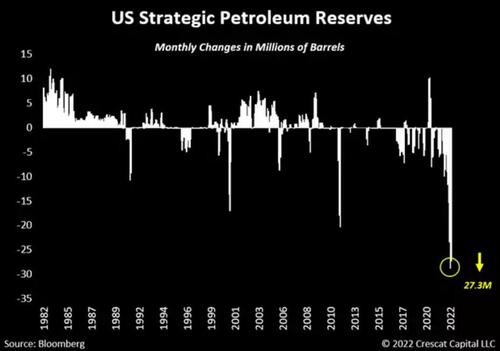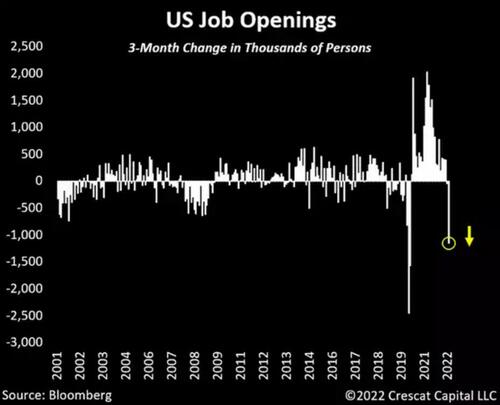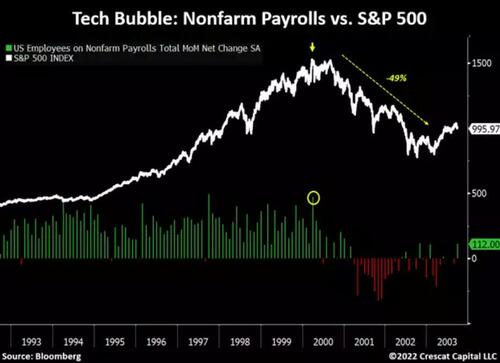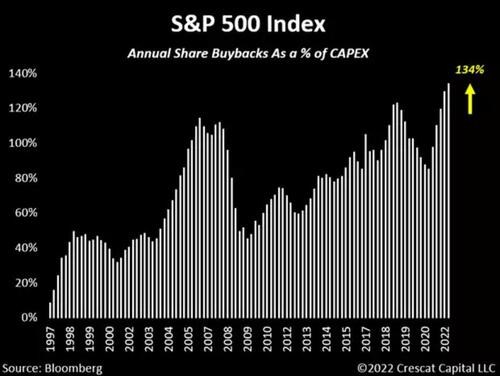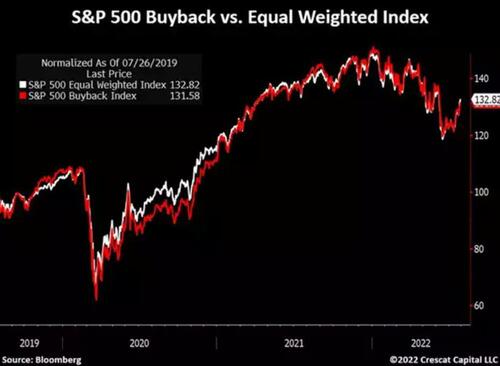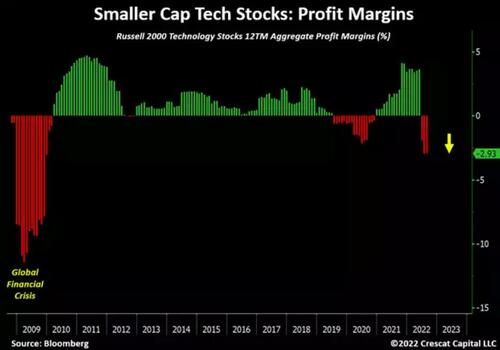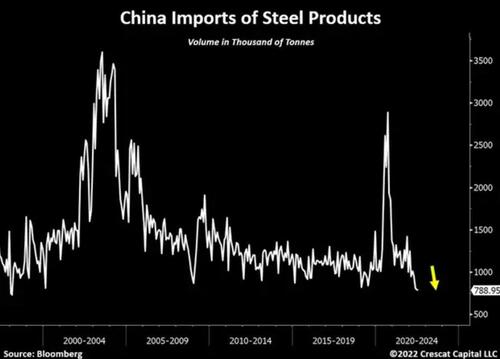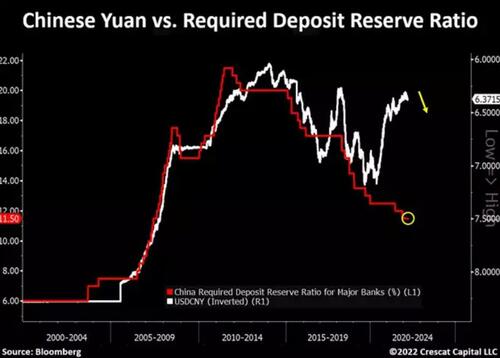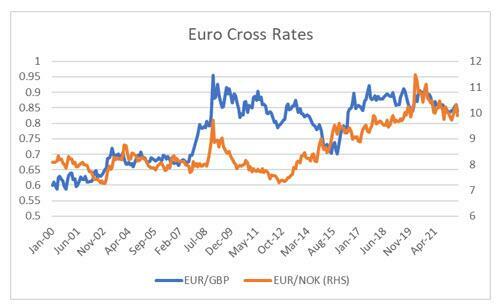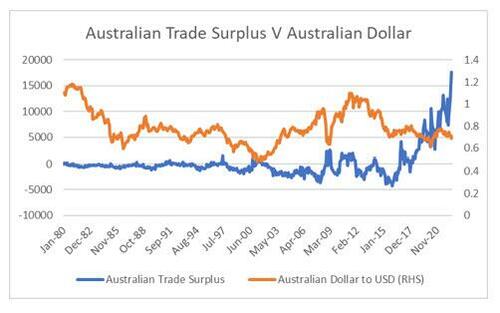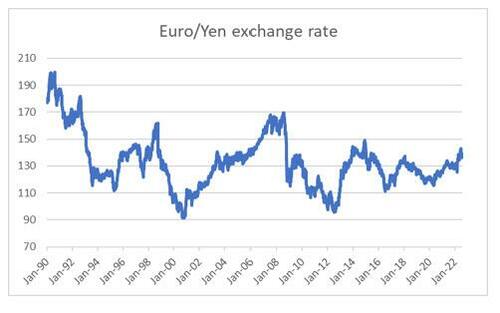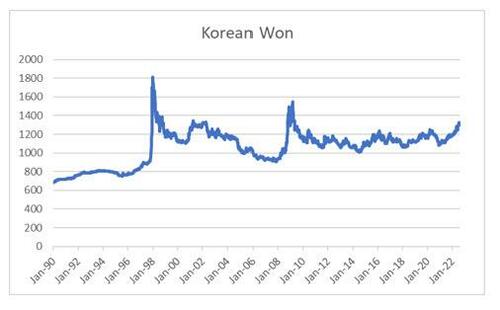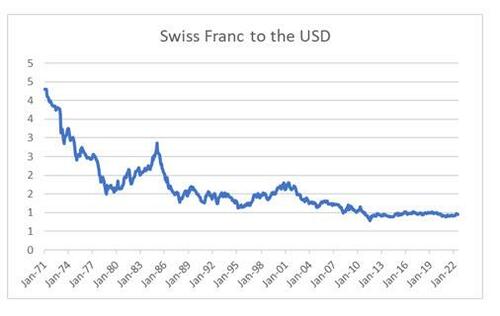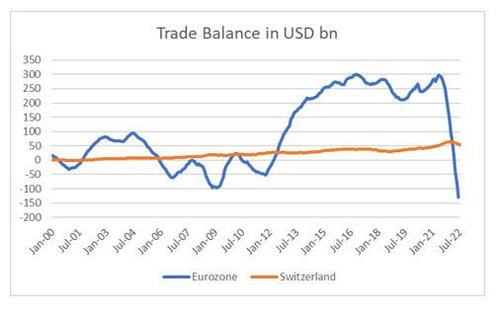Authored by Matthew Piepenburg via GoldSwitzerland.com,
With the USD losing influence, it would be the understatement of the year to say that we live in interesting times, for we certainly do.
But despite the inevitable attacks of appearing sensational, un-American or just plain cynical, I feel a more appropriate phrase boils down to this:
“We live in dishonest times.”
Below, I bluntly address the “Fed pivot debate,” the “inflation debate” and the USD’s slow global decline in the setting of a now multi-FX new normal in which gold’s historical bull market has yet to even begin.
These views are not based on biased politics, but honest economics, which for some odd reason, ought to still matter.
Let’s dig in.
The New Normal: Open Dishonesty
I recently authored a report showcasing a string cite of empirically open lies which now pass for reality on everything from the CPI inflation scale to the Cleveland Fed’s +1 real interest rate myth, or from official unemployment data to the now comical (revised) definition of a recession.
But a more recent lie from on high comes directly from the highest of all, U.S. President Joe Biden.
Earlier this month, Biden waddled to his podium and prompt-read to the world that the US just saw 0% inflation for the month of July.
Oh dear…
It’s sad when our national leadership lacks basic economic, math or even ethical skills, but then again, and in all fairness to a President in open (and in fact sad) cognitive decline, Biden is by no means the first President, red or blue, to just plain fib for a living.
A History of Fibbing
We all remember Clinton’s promise that allowing China into the WTO would be good for working class Americans, despite millions of them seeing their jobs off-shored to Asia seconds thereafter.
And let us not forget that little war in Iraq and those invisible weapons of mass destruction.
Nor should we ignore both Bush and Obama’s (as well as Geithner’s, Bernanke’s and Paulson’s) assurance that a multi-billion-dollar bailout (quasi-nationalization) of the TBTF banks and years of printing inflationary money (Wall St. socialism) out of thin air was, “a sacrifice of free market principles” needed to “save the free market economy.”
In reality, however, we haven’t seen a single minute of free market price discovery since QE1.
Thus, Biden’s announcement that there was NO inflation for July is just another clear and optically (i.e., politically) clever lie among a long history of lies.
That is, he failed to clarify that although there may have been LESS inflation in July, this hardly means “no” inflation, as any American who has a bill to pay already knows.
Setting the Stage (Narrative) for a Fed Pivot
What the July CPI decline does achieve, however, is yet another headline myth to justify an inevitable Fed pivot to more easy money by year-end (i.e., mid-term elections) or early 2023.
As we see below, the fiction writers, data-gatherers and fork-tongued policy makers in DC have already been gathering more official “data” to justify a Fed pivot toward more dovish money printing and hence more currency debasement ahead.
In addition to a decelerating CPI report for July, DC has also been checking the following, pre-pivot boxes to allow the Fed to get back to doing what it was truly designed to do, which is print debased money out of thin air to save the US Treasury market rather than working class citizens.
Specifically, DC is pushing hard on the following “data points” and narrative:
-
Decelerating inflation expectations
-
Declining online pricing
-
Declining PPI (Producer prices)
-
Declining oil prices (from their highs)
So, has inflation peaked? Are the above declines proof that inflation creates deflation by crushing consumer strength and hence price demand? Is the Fed’s work nearly done in defeating inflation?
My short answer is no, and my longer answer is that when it comes to market, currency and economic conditions, there’s…
…More Pain Ahead
One clear sign that there’s more pain ahead, and hence more reasons for the Fed to pivot from temporary hawk to permanent dove, is the credit tightening now taking place in the US.
As I’ve said too many times to recall, the credit—and bond—market is the most important market and economic indicator of all.
Earlier this month, the Fed’s quarterly Loan Officer Survey came out with some scary and telling news, namely that the credit markets are tightening.
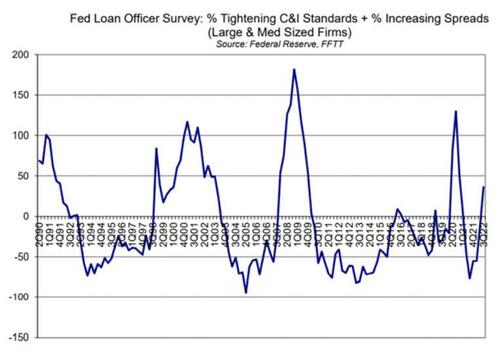
It’s important to know that in the last 30 years, a tightening of credit has always preceded a recession, even if DC wants to pretend that we are not in a recession.
The hawks may argue, of course, that during the inflationary 1970’s, tightening bank credit did NOT stop Volcker’s Fed from a hawkish rate hike policy.
But let me remind again that 2022 USA (with a 125% debt to GDP ratio) isn’t the Volcker era, which had a 30% ratio.
So, I’ll say it once more: The US can’t afford a sustained (Volcker-like) hawkish (rate-rising) policy–unless you believe the Fed is under direct orders from Davos to destroy America, which, I suppose is a fair belief, but one I’m not ready to embrace (yet)…
Despite Powell’s fear of becoming another Arthur F. Burns who let inflation run too hot, and despite his failed attempts throughout 2018, and again now, to be the tough-guy at the Fed, I still feel the Fed, for all the narrative points/reasons set forth above (including falling US tax receipts in July), is waiting for more weak economic data to justify a dovish pivot toward more QE rather than less inflation.
Why?
Because the Fed’s Only Job is to Keep Uncle Sam’s IOUs from Drowning
The only way to keep US Treasuries from tanking (and hence bond yields and interest rates from fatally spiking), is for the Fed to print more money to buy Uncle Sam’s otherwise unloved debt.
And this can only be done with more, not less, QE down the road.
Of course, money created with a mouse-click is inherently inflationary and inherently fatal to the purchasing power of the USD, which is why gold is inherently poised to out-perform every fiat currency in play today, including the world reserve currency.
But as for gold’s rise, in addition to the dis-inflationary recessionary forces (which require a weaker dollar and lower rates to fight), there’s a lot going on outside the US which further points to gold’s pending rise.
Little Trouble in Big China?
Investors may have noticed that money is fleeing China in droves. Capital outflows are reaching levels not seen since 2015, which sent the Yuan to the basement by 2016.
Does this mean the FX jocks should start shorting the heck out of the Chinese Yuan (CNY)?
I think not.
In fact, the CNY is holding its own despite massive capital outflows.
But how?
China: Openly Mocking the U.S. Dollar and the Back-Firing Putin Sanctions
The openly back-firing, financially-inept and politically-arrogant Western sanctions against Putin’s war amounted to the biggest game-changer in the global currency system since Nixon closed the gold window in 71.
More to the point, and despite massive capital outflows, the CNY is remaining strong because its FX reserves (i.e., its national savings account denominated in foreign assets) are actually rising not falling.
Huh? Why? Where’s the money coming from?
Answer: Just about everywhere except for the dollar-led West.
That is, nations like China and Russia, who have been chomping at the bit for the last decade to de-dollarize, are now doing precisely that in the wake of recent moves by the West to weaponize the USD by freezing Russia’s FX reserves.
Myopic sanction chest-puffing by the West has given the East the perfect pretext to fight back financially and monetarily, and they are fighting to win a heating currency war.
No Dollars, Thank You
Specifically, countries wishing to purchase Chinese imports (i.e., commodities) now have to pre-convert and/or settle those purchases from local currencies into CNY rather than the once SWIFT-and-world-dominated USD.
In short, the USD is no longer the toughest guy in the room nor prettiest girl at the dance.
This is becoming more evident as headlines confirm Indian companies swapping USDs for Asian currencies, China and Saudi Arabia concluding energy deals outside the slowly dying (and forewarned) petrodollar, and the Russian Central Bank considering buying the currencies of friendly nations like Turkey, India and China.
As commodities like oil (priced-up 30% since 2018) leave places like China and Russia, they can now be purchased with local national currencies (Indian, Brazilian, Turkish) which are then converted into CNY.
This procedure adds massively to China’s FX reserves (especially when oil prices have been rising), thereby allowing its currency to stay strong despite massive capital outflows.
From Mono-Currency to Multi-Currency
In short, and despite Western attempts to flex its currency muscle via USD-driven sanctions, nations like Russia and China are now leading the charge from a one-currency world to a multi-currency world of import payments.
With its FX reserves frozen by the West, Russia, for example, can take its energy profits and Rubbles to purchase the currencies of friendly countries like China, India and Turkey to rebuild its reserves outside of the USD.
In this manner, and as I’ve repeatedly warned (in articles and interviews) since February of 2022, the West has shot itself and the world reserve currency in the foot.
The old world is slowly but surely turning irreversibly away from a USD-dominated currency system toward a multi-currency and multi-FX pricing model.
And as we head into winter, nations like the UK, Japan, Austria and Germany, who blindly towed the US line, will be feeling the cold pinch of backing the wrong policy as other nations stay warm/heated with oil and gas that can be bought outside of the old, USD-led system.
As energy prices continue to cripple the West, especially here in the EU, will such nations like the UK, Austria or Germany bend or stay firm?

Either way, the USD is the open loser over time, and will never be trusted as neutral currency again.
But agree or disagree, you may still be asking: What does any of this have to do with gold?
It Has Everything to do with Gold
As more nations turn away from the West (and the USD) and closer to the East (i.e., Russia) to meet their energy needs, how will they find the Rubles or Yuan to buy their oil, gas and other commodities?
After all, in the new, post-sanction, multi-FX importing model described above, Turkey can’t just buy Russian oil in Lira; it needs to first settle the trade in Rubles.
So, again, what currency will Turkey use?
From Petro-Dollar to Petro-Gold
John Brimelow, a consistently brilliant gold analyst, has given us a pretty obvious hint/answer: YTD Turkish gold imports are up 44% to nearly 70 tonnes, and can easily reach prior levels of 300 tonnes per annum.
In other words, Turkey could be dumping US dollars to buy gold at what we all know is a deliberately rigged (i.e., low) COMEX/LBMA price.
Turkey can then sell that gold to Russia’s central bank in exchange for Rubles “at a negotiated price” otherwise needed to purchase Putin’s oil.
Given that the physical oil market is nearly 15X the physical gold market, one can only imagine what further oil-for-gold transactions as per above will do for the rising price of a scarce asset like gold.
See the Sea of Change?
See how the USD is slowly losing its shine?
See why gold is slowly gaining in shine?
See how the US-led sanctions were the biggest political and financial policy gaffe since Kamala Harris tried to locate the Ukraine on a map?
See why the BIS/COMEX/OTC price fixing of gold earlier this year was the perfect (and artificial, legalized fraud) timing needed to keep gold cheap for other nations to buy?
Rhetorical Questions
Perhaps all this interest in gold rather than the USD explains Saudi Arabia’s recent push to refine gold within its own borders?
Perhaps this also explains why less-favored nations to the US (i.e., Nigeria and India) are launching a bullion exchange and opening gold trading?
Perhaps gold’s new roles are why the BIS, the biggest player (legalized scammer) in the paper price fixing of gold, has unwound nearly 90% of its gold swaps over the course of a year (from 502 to 56 tonnes)?
And perhaps gold’s stubborn significance further explains why the two biggest US gold price manipulators in the futures pits, JP Morgan and Citi, have been grotesquely expanding their gold derivative book (they own 90% of all US derivative bank gold) at the same time the BIS was unwinding their swaps?
Why?
Simple: To keep a boot to the neck of the natural gold price just a bit longer as they accumulate more of the same before the very currency system they helped ruin finally implodes?
Honest not Sensational: Gold’s Bull Market Has Yet to Even Begin
Given the dishonest times in which we live, and given all the mechanizations sited above, it would not be sensational to remind conventional investors what most gold investors already know: Gold is most honest and loyal when dishonest and disloyal markets implode.
Hedge fund managers and other candid analysts are collectively and already foreseeing massive market pain ahead, as Egon and I have been warning for years.
The big boys are now net-short US Equity futures:
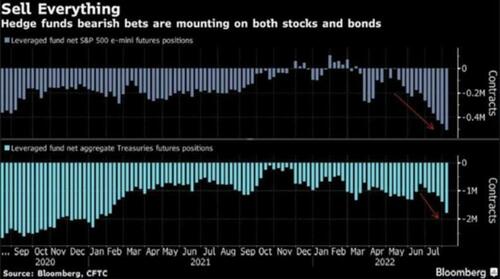
Whether re-valued by oil, or simply re-valued by fiat currencies which have increasingly no value, gold can easily reach levels which current investors can’t imagine.
After Nixon’s debacle in 1971, gold surged 400% in just one year between 1973-74.
Watch the Foxes, not the Hen House
The TBTF banks have no morality in my mind. I’ve written of their open fraud for years.
Ever since folks like Larry Summers repealed Glass Steagall and turned banks into casinos and bankers into speculators (with depositor money), nothing the big banks do is either fair or fiduciary.
Ironically, however, it is fair to say that even these banks will be hoarding more physical gold (at currently repressed/rigged prices) as the world they created implodes under its own systemic sins.
And if JP Morgan or Citi is getting prepared, shouldn’t you?
After all, better a fox than a hen, no?






